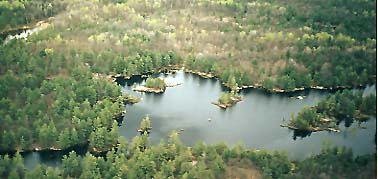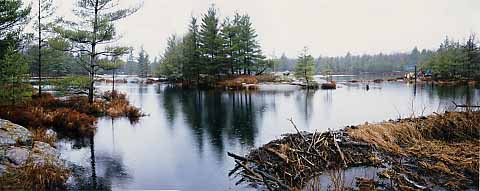 The most concrete change centers on the old farmbuildings. It is a sad thing, but in the years on either side of 1980, the cedar-shingled roofs all caved in, and now small trees -- birches -- grow inside.
The most concrete change centers on the old farmbuildings. It is a sad thing, but in the years on either side of 1980, the cedar-shingled roofs all caved in, and now small trees -- birches -- grow inside.

As a Centennial-Year conservation project, Mary Stuart, of the Ottawa Field-Naturalists' Club, acquired a 600-acre block of land deep in Lanark County's Pakenham Hills, an hour's drive west of Ottawa, Ontario. It was centered on an old, marginal farm, with long-empty log buildings and cramped hay fields that were still being rented out to local farmers.
But the little fields were surrounded by miles of forest, and most of the property was wild country. There were wetlands and woodlands, beaver ponds and barren rocky outcrops. The area was rich with birds and wildflowers. It was into this setting that Mary invited the Macoun Field Club, and we have been going there ever since.
 The most concrete change centers on the old farmbuildings. It is a sad thing, but in the years on either side of 1980, the cedar-shingled roofs all caved in, and now small trees -- birches -- grow inside.
The most concrete change centers on the old farmbuildings. It is a sad thing, but in the years on either side of 1980, the cedar-shingled roofs all caved in, and now small trees -- birches -- grow inside.
The remains of the old buildings are still worth visiting, though, for the log walls have held together and display the traces of long-lost pioneer arts, such as hand-hewn timbers and dove-tailed corners. The logs themselves reveal evidence of the old-growth forests from which they were cut, very different in character from the second-growth woodlands of today.
And yet forests there are, of White Pine on the ridge tops and Red Maple in the lowlands, with groves of Red Oak and Trembling Aspen in other places. Mostly hidden from view at ground level, the land is dotted with ponds when seen from the air. Each one drains into the pond below, in a sparkling chain that eventually feeds Indian Creek, the area's main watercourse.
 The architect of all these ponds is the beaver, an animal that was wiped out across much of eastern Canada by unrestrained trapping a hundred years ago. After the efforts of individuals like Grey Owl, and the development of wildlife management as an effective discipline, the beaver came back to lands like these. They reached the Pakenham Hills in the early 1950s, and the Macoun Club's nature Study Area in Ottawa a decade later. Almost all the beaverponds we see now in both places date from that period of resurgence. The original dams have been maintained by each successive generation of beavers.
The architect of all these ponds is the beaver, an animal that was wiped out across much of eastern Canada by unrestrained trapping a hundred years ago. After the efforts of individuals like Grey Owl, and the development of wildlife management as an effective discipline, the beaver came back to lands like these. They reached the Pakenham Hills in the early 1950s, and the Macoun Club's nature Study Area in Ottawa a decade later. Almost all the beaverponds we see now in both places date from that period of resurgence. The original dams have been maintained by each successive generation of beavers.
One of our favourite places seems so much more than just a pond that Mary herself called it "the upper lake". High up on a plateau, it so is beautifully rimmed with sun-bleached granite and ringed by soft green pines that we have never found a better place in all our wanderings. Many, many Macouners have made camp here and spent time on that little island farthest left.
 Seen from the opposite direction, the little island lies close to an exposed point (at right), where for years Macoun Club campers have been making their campfires. The dam in the foreground is five feet high. The water side is faced with mud from top to bottom, while on the downstream side, a bracing of sticks holds it in place against the press of water. The sticks have recently been renewed on the left side, but to the right the whole mass is neglected and overgrown with sedges.
Seen from the opposite direction, the little island lies close to an exposed point (at right), where for years Macoun Club campers have been making their campfires. The dam in the foreground is five feet high. The water side is faced with mud from top to bottom, while on the downstream side, a bracing of sticks holds it in place against the press of water. The sticks have recently been renewed on the left side, but to the right the whole mass is neglected and overgrown with sedges.
 Macouners have slept in tents, weathered storms under tarps and canoes, and best of all, laid out their sleeping bags under the open sky. The stars can still be brilliant, though the night itself is no longer dark. Like the world as a whole, Ottawa's population has doubled since Mary bought her land in 1967, and the city's nearest edge (Kanata) is now less than 25 miles away! Its approaching light dome flares ever higher in the east, burning away the beautiful, natural darkness that is now so rarely experienced.
Macouners have slept in tents, weathered storms under tarps and canoes, and best of all, laid out their sleeping bags under the open sky. The stars can still be brilliant, though the night itself is no longer dark. Like the world as a whole, Ottawa's population has doubled since Mary bought her land in 1967, and the city's nearest edge (Kanata) is now less than 25 miles away! Its approaching light dome flares ever higher in the east, burning away the beautiful, natural darkness that is now so rarely experienced.
As naturalists, Mary Stuart's is forest and pond to us, beaver and bear, heron, frog, and snowflea. As Macouners, it is also memories -- memories of talking late into the night, of waking startled in the dark to hear Coyotes somewhere close by, of rising late and stretching cold hands toward the breakfast fire. Here around the porridge pot are Rob Lee, Andy Wagner, William Godsoe, and Hugo Kitching. The date was October 24th, 1999.
Rob is still leader, and these boys have all been at university for years. What are they all doing? What has become of Mary Stuart? Answers to these and other questions will come on succeeding pages, yet to be designed. In the meantime, that blackened pot is still there, stored under the old canoe, and we've been so sparing of the firewood all these years that there's plenty left for times to come.
All photos donated or provided by members and leaders, past and present. Created Nov. 10, 2005; updated Jan. 29, 2007.